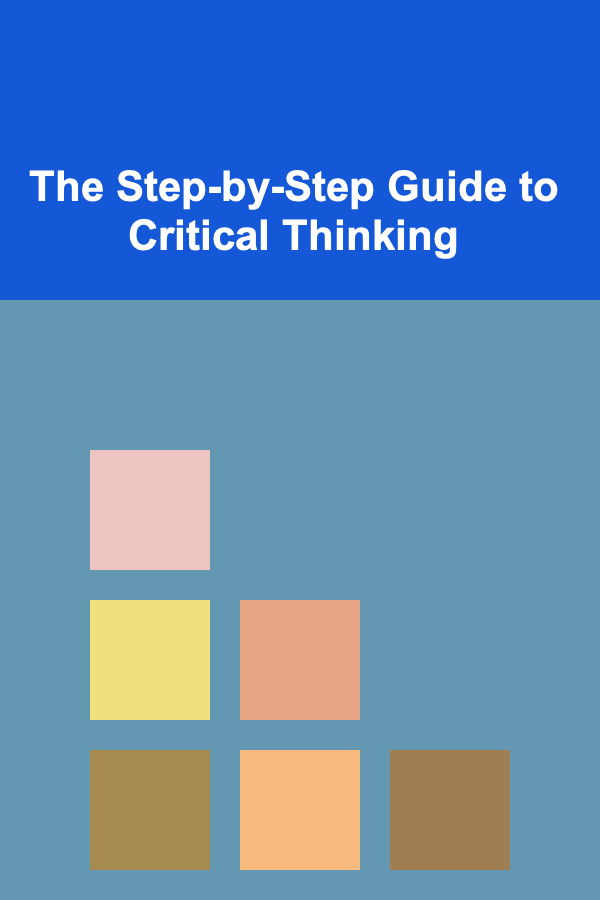
The Step-by-Step Guide to Critical Thinking
ebook include PDF & Audio bundle (Micro Guide)
$12.99$6.99
Limited Time Offer! Order within the next:

Critical thinking is a vital skill that empowers individuals to analyze, evaluate, and synthesize information effectively. It involves questioning assumptions, exploring alternative perspectives, and making decisions based on evidence and reasoned argument. The ability to think critically enhances problem-solving, decision-making, and communication, making it indispensable in both personal and professional settings.
This guide will provide a comprehensive, step-by-step overview of critical thinking, its importance, and practical strategies to cultivate and apply it in everyday situations.
What Is Critical Thinking?
Critical thinking is the process of actively and skillfully conceptualizing, analyzing, synthesizing, evaluating, and reflecting on information to guide decision-making, belief formation, or problem-solving. It is not just about gathering information, but also about questioning the information, its sources, and the reasoning behind it. Critical thinking requires an open mind, a healthy level of skepticism, and the ability to evaluate claims based on logic and evidence.
The key components of critical thinking include:
- Analysis: Breaking down complex information into smaller, manageable parts.
- Evaluation: Assessing the validity and reliability of information and arguments.
- Inference: Drawing conclusions based on the available evidence.
- Interpretation: Understanding the meaning of information and recognizing its implications.
- Explanation: Articulating the reasoning behind a decision or judgment.
- Self-regulation: Reflecting on one's thinking and biases, and adjusting it when necessary.
By engaging in critical thinking, individuals are better equipped to make informed decisions, solve problems creatively, and communicate ideas effectively.
Why Is Critical Thinking Important?
Critical thinking is essential for a number of reasons. It shapes how we approach problems, understand complex issues, and navigate a world filled with misinformation. Here's why it's so crucial:
1. Enhanced Problem-Solving Abilities
Critical thinking allows individuals to approach problems with a structured and rational mindset. Instead of reacting impulsively, critical thinkers analyze the problem, explore possible solutions, and evaluate the outcomes before making a decision.
2. Better Decision-Making
When faced with multiple choices, critical thinkers are able to weigh the pros and cons of each option, considering all relevant factors. This leads to better-informed decisions and reduces the risk of regrettable choices.
3. Improved Communication Skills
Critical thinkers can articulate their ideas clearly and logically, making their arguments more persuasive and coherent. They can also evaluate the strengths and weaknesses of others' arguments, which enhances their ability to engage in meaningful discussions.
4. Reduction of Bias and Cognitive Distortions
Critical thinking helps individuals identify and challenge their own biases and cognitive distortions. By evaluating information objectively, individuals can reduce the influence of emotions or preconceived notions on their thinking.
5. Increased Creativity
Although it may seem counterintuitive, critical thinking fosters creativity. By breaking down complex problems and evaluating multiple perspectives, individuals can come up with innovative solutions that they might not have otherwise considered.
6. Resilience in the Face of Challenges
Critical thinking fosters resilience by encouraging individuals to remain calm and methodical when faced with challenges. Instead of succumbing to stress or panic, critical thinkers stay focused and work through obstacles in a logical and reasoned manner.
The Step-by-Step Process of Critical Thinking
Critical thinking is a deliberate process that involves several key steps. Let's break down the process step by step.
Step 1: Identify the Problem or Question
Critical thinking begins with recognizing the issue at hand. This could be a problem that needs solving, a decision that needs to be made, or a question that needs answering. Clear identification of the problem is crucial because it sets the stage for the entire thinking process.
Ask yourself:
- What exactly am I trying to solve or understand?
- What information do I need to answer this question?
- What are the potential implications of this problem?
Step 2: Gather Information
Once the problem or question is identified, the next step is to gather relevant information. This involves seeking out facts, data, and evidence that can help illuminate the issue. In this stage, it's important to draw from a variety of credible sources to get a comprehensive understanding of the topic.
Ask yourself:
- What information do I already know about this topic?
- Where can I find reliable and accurate information?
- Are there any sources that may be biased or unreliable?
Step 3: Analyze the Information
After gathering information, it's time to analyze it. This involves looking at the data critically, breaking it down into smaller components, and identifying patterns, trends, and relationships. In this step, it's essential to focus on both the big picture and the finer details.
Ask yourself:
- What are the key points or arguments?
- Are there any inconsistencies or contradictions in the information?
- What assumptions are being made?
Step 4: Evaluate the Evidence
Evaluating the evidence is a critical step in the process of critical thinking. It involves assessing the quality, relevance, and credibility of the information. Not all evidence is created equal, and some may be more reliable or applicable than others.
Ask yourself:
- Is the evidence reliable and credible?
- Does the evidence support the claims being made?
- Are there any logical fallacies or weaknesses in the argument?
Step 5: Consider Alternatives and Perspectives
Critical thinking requires openness to multiple perspectives and alternative solutions. Instead of accepting the first solution or conclusion that comes to mind, take the time to explore other options and viewpoints. This step ensures that you are not locked into a narrow way of thinking.
Ask yourself:
- What are the possible alternatives or solutions?
- How might different perspectives influence my understanding of the issue?
- What would happen if I approached the problem from a different angle?
Step 6: Draw Conclusions
Based on the analysis, evaluation, and consideration of alternatives, it's time to draw conclusions. This involves synthesizing the information and making an informed decision or judgment. The conclusion should be based on logic, evidence, and reasoning rather than on emotions or biases.
Ask yourself:
- What is the most reasonable conclusion based on the evidence?
- How does my conclusion address the problem or question?
- Are there any gaps in my reasoning that need to be addressed?
Step 7: Reflect and Revise
The final step in critical thinking is reflection. This involves reviewing your thinking process to identify any mistakes, biases, or assumptions that may have influenced your conclusion. If necessary, revise your reasoning and conclusions based on new evidence or insights.
Ask yourself:
- Did I consider all relevant information and viewpoints?
- Was I influenced by any biases or assumptions?
- How can I improve my thinking process for next time?
Practical Tips for Developing Critical Thinking
While the step-by-step process of critical thinking provides a structured approach, it takes practice to develop this skill. Here are some practical tips to help you strengthen your critical thinking abilities:
1. Ask Open-Ended Questions
Open-ended questions encourage deeper exploration and critical analysis. Instead of asking questions that can be answered with a simple "yes" or "no," ask questions that require thoughtful consideration, such as "Why?" or "How?"
2. Challenge Your Assumptions
We all carry assumptions, many of which are formed based on past experiences or societal norms. Critical thinkers regularly challenge their assumptions by asking whether they are valid and by seeking evidence to support or disprove them.
3. Engage in Discussions and Debates
Engaging in discussions and debates with others helps you refine your thinking and exposes you to different perspectives. Listen carefully to opposing viewpoints, and be open to changing your mind when presented with compelling evidence.
4. Practice Reflective Thinking
Take time to reflect on your decisions and thought processes. This helps you identify areas for improvement and reinforces the importance of careful, deliberate thinking.
5. Avoid Cognitive Biases
Be mindful of common cognitive biases, such as confirmation bias or availability bias, which can cloud judgment and lead to flawed reasoning. Strive to approach problems with an open mind and a focus on objective evidence.
Conclusion
Critical thinking is an invaluable skill that enhances decision-making, problem-solving, and communication. By following a systematic process of identifying problems, gathering information, analyzing evidence, considering alternatives, and drawing conclusions, individuals can improve their ability to think clearly, logically, and objectively. Developing critical thinking requires practice and self-reflection, but the benefits---better decisions, improved relationships, and enhanced creativity---are well worth the effort.
By embracing critical thinking, you empower yourself to navigate an increasingly complex world with clarity and confidence, making informed choices that lead to personal and professional success.

How to Create a Holiday Decoration Inventory List
Read More
How to Handle Emergency Repairs in Your Rental Property
Read More
How to Use Color Psychology in Home Staging for Better Buyer Perception
Read More
How To Understand the Legal Aspects of Esports Contracts
Read More
How to Find Free Walking Tours
Read More
How to Use an Event Planning Checklist for Virtual Conferences
Read MoreOther Products

How to Create a Holiday Decoration Inventory List
Read More
How to Handle Emergency Repairs in Your Rental Property
Read More
How to Use Color Psychology in Home Staging for Better Buyer Perception
Read More
How To Understand the Legal Aspects of Esports Contracts
Read More
How to Find Free Walking Tours
Read More